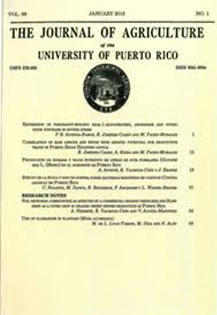Abstract
Capsicum chinense is a small aromatic pepper native to the Amazon and widely used in the Caribbean Basin. Most types of C. chinense are highly pungent, but landraces in Puerto Rico generally have little or no pungency. This “sweet chili pepper” (or ají dulce, as it is known on the Island) is an integral part of the local cuisine. Ten sweet chili pepper lines derived from non-pungent landraces were evaluated in Lajas, Juana Díaz and Corozal, Puerto Rico, in 2009. The lines represented a diversity of fruit types common on the Island. Plants in Juana Díaz grew to about twice the height of those in Lajas and Corozal. Fruit yield varied from 809 g/plant in Lajas to 1,420 g/plant in Juana Díaz. Planting density (number of plants per hectare) was greater at Corozal compared to the other two locations, resulting in a yield per hectare similar to that of Juana Díaz (10,210 kg/ha in Juana Díaz; 10,112 kg/ha in Corozal). Yield was much lower in Lajas (6,400 kg/ha). Average fruit weight was greatest at Juana Díaz (12.1 g) and lowest at Corozal (10.0 g). Plant height at 11 weeks was weakly correlated (r = 0.33) with fruit yield. Plants infected by at least one of three genera of viruses, Cucumovirus, Tobamovirus and Potyvirus, were found at each location. Seed weight per 500 seeds averaged 2.34 g. The average fruit produced about 23 seeds. Genotype x environment (GxE) interaction (= line x location) was highly significant for height, number of fruit and fruit yield, but not for average fruit weight. Because of GxE interaction, the best performing lines varied, depending on location. The presence of GxE interaction presents challenges to a sweet chili pepper breeding program. Although it may be difficult to develop cultivars that perform equally well over diverse environments, improved cultivars with virus resistance should result in increased production. More research is needed to better understand the impact that variation in planting density has on sweet chili pepper yields.

